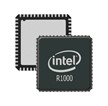RFID Chip: Intel Launches UHF RFID Reader Radio Chip

Intel Corporation recently introduced an RFID radio chip that will enhance the capabilities and design of UHF RFID readers. The Intel UHF RFID Transceiver R1000 (or Intel R1000) provides unprecedented levels of design flexibility by integrating approximately 90 percent of the discrete components found in a typical RFID reader radio  (including receive, transmit, baseband, modulation and demodulation functionality) onto a single chip. The Intel R1000 delivers high performance with significantly lower power consumption, supporting a full range of reader form factors and applications, from short-range handheld readers to long-range dock door readers, claims Intel.
(including receive, transmit, baseband, modulation and demodulation functionality) onto a single chip. The Intel R1000 delivers high performance with significantly lower power consumption, supporting a full range of reader form factors and applications, from short-range handheld readers to long-range dock door readers, claims Intel.
UHF RFID readers are used for a wide range of applications across vertical markets, including supply chain management, asset tracking, authentication and access control. While RFID technology has matured to the point where standards are now in place and tags are inexpensive, RFID readers tend to be large, complex and expensive, with high power requirements and hundreds of discrete components. The Intel R1000 significantly changes this model by integrating most of the reader's components onto a single 8 millimeter (mm) by 8mm chip. This reduces design complexity and costs, which enables manufacturers to develop smaller, innovative readers and address new end-user RFID applications.
"Integrated radio silicon in readers is an important step in the evolution of UHF RFID," said Michael J. Reed, Intel RFID Operation general manager. "Companies will now have access to low-cost, low-power and more versatile readers, better equipping them to explore the boundless opportunities afforded by RFID."
The Intel R1000 is packaged with several development tools that speed time-to-market for reader OEMs and ease reader deployment, provisioning and remote management for end-users. Firmware included with the Intel R1000 supports all modes and data rates of the EPCglobal Gen 2 and ISO 18000-6C standards, including built-in support for dense reader mode (DRM), and regional regulatory requirements such as FCC and ETSI, including built-in support for listen before talk (LBT). Normally a company would need to invest six to 12 months to develop this protocol firmware.
While developing the Intel R1000, Intel also worked closely with end-users and enterprise software companies to create a software stack that provides the device diagnostics, management, and provisioning required for successful enterprise-wide deployments. This enables superior integration and data management throughout the enterprise, from the reader to the data center. The result is a low-level software solution and software design kit (SDK) from Intel based on the Intel R1000, compatible with the industry's leading software providers' higher-level applications and emerging standards. The SDK also allows customers to program readers using common programming techniques rather than having to understand and develop low-level microcontroller code.
The Intel R1000 has already received broad industry support among RFID reader manufacturers. Many are developing readers with the Intel R1000, with products expected to be commercially available in North America, Europe and Asia during the second quarter of 2007. Additional information about the Intel R1000 is available at www.intel.com/go/R1000.
Intel, the world leader in silicon innovation, develops technologies, products and initiatives to continually advance how people work and live. Additional information about Intel is available at www.intel.com/pressroom
CONTACT:
Joshua Lefkowitz
Burson-Marsteller for Intel
(212) 614-5012
joshua.lefkowitz@bm.com
SOURCE: Intel Corporation
